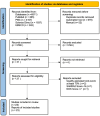Comparative Efficacy and Safety of Novel Antiplatelets and Standard Therapy in Patients With Coronary Artery Disease
- PMID: 39534810
- PMCID: PMC11554594
- DOI: 10.7759/cureus.71333
Comparative Efficacy and Safety of Novel Antiplatelets and Standard Therapy in Patients With Coronary Artery Disease
Abstract
Coronary artery disease (CAD) is a significant health concern that has affected approximately 110 million people worldwide. CAD is defined as persistent narrowing of the coronary arteries as a result of atherosclerotic plaque build-up. Acute coronary syndrome (ACS), which encompasses ST-elevation myocardial infarction (STEMI), non-ST-elevation myocardial infarction (NSTEMI), and unstable angina, often results from plaque ruptures. Platelets are crucial for atherogenesis, vascular inflammation, and oxidative stress. Antiplatelet therapy aimed at reducing thrombotic events is vital for ACS treatment. Clinical guidelines advise the use of dual antiplatelet therapy (DAPT) that combines aspirin and a P2Y12 receptor inhibitor (clopidogrel, prasugrel, or ticagrelor) in ACS patients undergoing percutaneous intervention (PCI). This study aimed to assess comprehensively the effectiveness and safety of ticagrelor and prasugrel in comparison to clopidogrel in patients with ACS. An extensive literature search was conducted using PubMed, PubMed Central (PMC), ScienceDirect, and EBSCO databases. The search revealed studies that compared ticagrelor and prasugrel to clopidogrel in ACS patients, and we selected these studies based on specific inclusion and exclusion criteria, which included observational studies, clinical trials, literature reviews, and meta-analyses involving adult ACS patients treated with ticagrelor, prasugrel, or clopidogrel. The efficacy outcomes were defined as major adverse cardiovascular events (MACE) and thrombotic events, whereas the safety outcomes were measured by major and minor bleeding and hemorrhagic stroke. After a rigorous quality assessment to minimize bias, 23 studies were selected for analysis. The findings indicated that novel antiplatelets reduced MACE but increased bleeding complications, with ticagrelor consistently associated with dyspnea. In conclusion, novel P2Y12 inhibitors provide cardiovascular benefits but require careful patient selection and monitoring due to gastrointestinal bleeding (GIB) risks. Future research should standardize bleeding definitions and assess long-term outcomes. Ticagrelor and prasugrel may be more effective and safer than clopidogrel in ACS patients. Given the high risk of GIB, especially among older individuals or those with a past stroke, it is advisable to suggest a lower prasugrel dose without raising the bleeding rates. Since fewer patients use the novel antiplatelet regimen compared to clopidogrel, future clinical trials should include a broader patient population and compare these regimens.
Keywords: acute coronary syndrome (acs); clopidogrel; coronary artery disease (cad); dual-antiplatelet therapy (dapt); gastrointestinal bleeding (gib); p2y12 antagonists; prasugrel; safety and efficacy; systematic review; ticagrelor.
Copyright © 2024, Gangavarapu et al.
Conflict of interest statement
Conflicts of interest: In compliance with the ICMJE uniform disclosure form, all authors declare the following: Payment/services info: All authors have declared that no financial support was received from any organization for the submitted work. Financial relationships: All authors have declared that they have no financial relationships at present or within the previous three years with any organizations that might have an interest in the submitted work. Other relationships: All authors have declared that there are no other relationships or activities that could appear to have influenced the submitted work.
Figures




Similar articles
-
Bleeding risk in patients prescribed dual antiplatelet therapy and triple therapy after coronary interventions: the ADAPTT retrospective population-based cohort studies.Health Technol Assess. 2023 May;27(8):1-257. doi: 10.3310/MNJY9014. Health Technol Assess. 2023. PMID: 37435838 Free PMC article.
-
Fewer gastrointestinal bleeds with ticagrelor and prasugrel compared with clopidogrel in patients with acute coronary syndrome following percutaneous coronary intervention.Aliment Pharmacol Ther. 2020 Aug;52(4):646-654. doi: 10.1111/apt.15790. Epub 2020 Jul 13. Aliment Pharmacol Ther. 2020. PMID: 32657466 Free PMC article.
-
Contemporary antiplatelet treatment in acute coronary syndrome patients undergoing percutaneous coronary intervention: 1-year outcomes from the GReek AntiPlatElet (GRAPE) Registry.J Thromb Haemost. 2016 Jun;14(6):1146-54. doi: 10.1111/jth.13316. Epub 2016 May 4. J Thromb Haemost. 2016. PMID: 26990959
-
Oral Antiplatelet Therapy After Acute Coronary Syndrome: A Review.JAMA. 2021 Apr 20;325(15):1545-1555. doi: 10.1001/jama.2021.0716. JAMA. 2021. PMID: 33877270 Review.
-
Did Prasugrel and Ticagrelor Offer the Same Benefit in Patients with Acute Coronary Syndromes after Percutaneous Coronary Interventions Compared to Clopidogrel? Insights from Randomized Clinical Trials, Registries and Meta-analysis.Curr Pharm Des. 2018;24(4):465-477. doi: 10.2174/1381612824666180108121834. Curr Pharm Des. 2018. PMID: 29308737 Review.
Cited by
-
Identification and Management Strategies for Intracoronary High Thrombus Burden in Patients With STEMI: A Practical Experience and Literature Review.Rev Cardiovasc Med. 2025 Jul 30;26(7):37466. doi: 10.31083/RCM37466. eCollection 2025 Jul. Rev Cardiovasc Med. 2025. PMID: 40776951 Free PMC article. Review.
References
-
- 2024 heart disease and stroke statistics: a report of US and global data from the American Heart Association. Martin SS, Aday AW, Almarzooq ZI, et al. Circulation. 2024;149:0–913. - PubMed
-
- Mechanisms of plaque formation and rupture. Bentzon JF, Otsuka F, Virmani R, Falk E. Circ Res. 2014;114:1852–1866. - PubMed
-
- Acute coronary syndrome (unstable angina and non-ST elevation MI) Sarkees ML, Bavry AA. https://www.ncbi.nlm.nih.gov/pmc/articles/PMC2907796/#:~:text=Definition... BMJ Clin Evid. 2009;2009 - PMC - PubMed
Publication types
LinkOut - more resources
Full Text Sources
Miscellaneous
